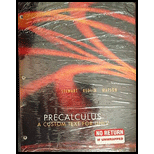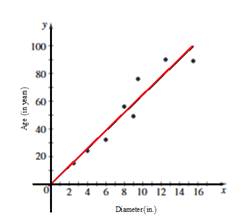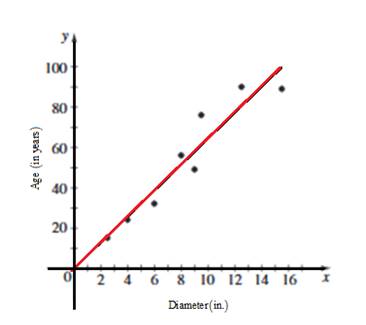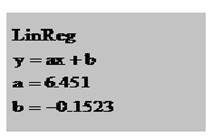
Concept explainers
a.
Make a
a.
Answer to Problem 3P

Explanation of Solution
Given information:
To estimate ages of trees, forest rangers use a linear model that relates tree diameter to age. The model is useful because tree diameter is much easier to measure than tree age (which requires special tools for extracting a representative cross-section of the tree and counting the rings). To find the model, use the data in the table, which were collected for a certain variety of oaks.
Calculation:
The scatter plot of the data is given as,

Hence, the graph is shown above.
b.
Find and graph a linear function that models the data.
b.
Answer to Problem 3P
Explanation of Solution
Given information:
To estimate ages of trees, forest rangers use a linear model that relates tree diameter to age. The model is useful because tree diameter is much easier to measure than tree age (which requires special tools for extracting a representative cross-section of the tree and counting the rings). To find the model, use the data in the table, which were collected for a certain variety of oaks.
Calculation:
Using a calculator, we find the following regression line that models the data in the form of,
Using regression calculator,

Substituting
Hence, the linear function that models the data is
c.
Use the model to estimate the age of an oak whose diameter is
c.
Answer to Problem 3P
Explanation of Solution
Given information:
To estimate ages of trees, forest rangers use a linear model that relates tree diameter to age. The model is useful because tree diameter is much easier to measure than tree age (which requires special tools for extracting a representative cross-section of the tree and counting the rings). To find the model, use the data in the table, which were collected for a certain variety of oaks.
Calculation:
The diameter
Hence, the estimated age of an oak whose diameter is
Chapter 1 Solutions
Precalculus - A Custom Text for UNLV
- Consider the following system of equations, Ax=b : x+2y+3z - w = 2 2x4z2w = 3 -x+6y+17z7w = 0 -9x-2y+13z7w = -14 a. Find the solution to the system. Write it as a parametric equation. You can use a computer to do the row reduction. b. What is a geometric description of the solution? Explain how you know. c. Write the solution in vector form? d. What is the solution to the homogeneous system, Ax=0?arrow_forward2. Find a matrix A with the following qualities a. A is 3 x 3. b. The matrix A is not lower triangular and is not upper triangular. c. At least one value in each row is not a 1, 2,-1, -2, or 0 d. A is invertible.arrow_forwardFind the exact area inside r=2sin(2\theta ) and outside r=\sqrt(3)arrow_forward
- A 20 foot ladder rests on level ground; its head (top) is against a vertical wall. The bottom of the ladder begins by being 12 feet from the wall but begins moving away at the rate of 0.1 feet per second. At what rate is the top of the ladder slipping down the wall? You may use a calculator.arrow_forwardExplain the focus and reasons for establishment of 12.4.1(root test) and 12.4.2(ratio test)arrow_forwarduse Integration by Parts to derive 12.6.1arrow_forward
- Explain the relationship between 12.3.6, (case A of 12.3.6) and 12.3.7arrow_forwardExplain the key points and reasons for the establishment of 12.3.2(integral Test)arrow_forwardUse 12.4.2 to determine whether the infinite series on the right side of equation 12.6.5, 12.6.6 and 12.6.7 converges for every real number x.arrow_forward
 Calculus: Early TranscendentalsCalculusISBN:9781285741550Author:James StewartPublisher:Cengage Learning
Calculus: Early TranscendentalsCalculusISBN:9781285741550Author:James StewartPublisher:Cengage Learning Thomas' Calculus (14th Edition)CalculusISBN:9780134438986Author:Joel R. Hass, Christopher E. Heil, Maurice D. WeirPublisher:PEARSON
Thomas' Calculus (14th Edition)CalculusISBN:9780134438986Author:Joel R. Hass, Christopher E. Heil, Maurice D. WeirPublisher:PEARSON Calculus: Early Transcendentals (3rd Edition)CalculusISBN:9780134763644Author:William L. Briggs, Lyle Cochran, Bernard Gillett, Eric SchulzPublisher:PEARSON
Calculus: Early Transcendentals (3rd Edition)CalculusISBN:9780134763644Author:William L. Briggs, Lyle Cochran, Bernard Gillett, Eric SchulzPublisher:PEARSON Calculus: Early TranscendentalsCalculusISBN:9781319050740Author:Jon Rogawski, Colin Adams, Robert FranzosaPublisher:W. H. Freeman
Calculus: Early TranscendentalsCalculusISBN:9781319050740Author:Jon Rogawski, Colin Adams, Robert FranzosaPublisher:W. H. Freeman
 Calculus: Early Transcendental FunctionsCalculusISBN:9781337552516Author:Ron Larson, Bruce H. EdwardsPublisher:Cengage Learning
Calculus: Early Transcendental FunctionsCalculusISBN:9781337552516Author:Ron Larson, Bruce H. EdwardsPublisher:Cengage Learning





